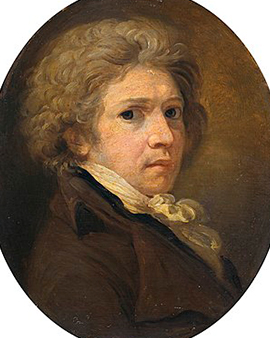In the shimmering art scene of neoclassical Italy, the 18th century produced the extraordinary Andrea Appiani, whose birth greeted the world in Milan on May 31, 1754. However, the vibrant streets of Milan not only held his story, but also hid the subtle nuances of his artistic transformations.
Originally destined to follow in his father's medical footsteps, Appiani pursued a different, passionate calling. He sought out the tutelage of the renowned Carlo Maria Giudici, under whose aegis he mastered the art of drawing, copying sculptures and art prints with meticulous dedication. Those early days led him to the creative spaces of Antonio de' Giorgi and Martin Knoller, where he immersed himself in the mystique of fresco painting and oil painting. Every brushstroke, every art print he created was a silent ode to his tireless devotion to art.
Among Appiani's most notable works are a symphonic depiction of the Evangelists in the church of Santa Maria presso San Celso and a magical fresco in Milan's Royal Villa depicting Apollo and the Muses in their full glory. But life had not only praise and honor in store for Appiani. When Napoleon fell, the painter's privileges disappeared with him, and an unexpected poverty enveloped him. Yet even in these times, he created masterful portraits and narrative works that reflected the ages. One of his most remarkable paintings recounts the touching encounter of Rachel and Jacob, a timeless piece that shines today in Alzano.
His life ended in Milan in 1817, but his legacy continued to flourish through students like Antonio De Antoni and Giuseppe Bossi. They carry on the legacy of an artist whose works now adorn the walls of art lovers around the world as art prints, reproduced in the highest quality.
×





.jpg)
.jpg)
.jpg)
.jpg)
.jpg)
.jpg)
.jpg)
.jpg)
_Fresco_by_Andrea_Appiani_(1754-1817)_Dim_116x1_-_(MeisterDrucke-1053073).jpg)
_Fresco_by_Andrea_Appiani_(1754-1817)_Dim_116x1_-_(MeisterDrucke-1053073).jpg)
_Ita_-_(MeisterDrucke-1082297).jpg)
_Ita_-_(MeisterDrucke-1082297).jpg)
 King of Italy c1805-10 - (MeisterDrucke-50359).jpg)
 King of Italy c1805-10 - (MeisterDrucke-50359).jpg)
_-_(MeisterDrucke-61122).jpg)
_-_(MeisterDrucke-61122).jpg)
.jpg)
.jpg)
.jpg)
.jpg)
.jpg)
.jpg)
 Viceroy of Italy and Duke of Leuchtenberg 1810 - (MeisterDrucke-115028).jpg)
 Viceroy of Italy and Duke of Leuchtenberg 1810 - (MeisterDrucke-115028).jpg)
_-_(MeisterDrucke-1475584).jpg)
_-_(MeisterDrucke-1475584).jpg)
.jpg)
.jpg)
.jpg)
.jpg)
_Marquis_of_Breme_Min_-_(MeisterDrucke-1119591).jpg)
_Marquis_of_Breme_Min_-_(MeisterDrucke-1119591).jpg)
_Museo_del_Risorg_-_(MeisterDrucke-972575).jpg)
_Museo_del_Risorg_-_(MeisterDrucke-972575).jpg)
.jpg)
.jpg)
.jpg)
.jpg)
.jpg)
.jpg)
_Villa_Reale_Monza_Italy_-_(MeisterDrucke-1109920).jpg)
_Villa_Reale_Monza_Italy_-_(MeisterDrucke-1109920).jpg)
.jpg)
.jpg)
.jpg)
.jpg)
 1800 - (MeisterDrucke-67410).jpg)
 1800 - (MeisterDrucke-67410).jpg)
.jpg)
.jpg)
_-_1800_-_Etching_watercolour_-_407x33_-_-_(MeisterDrucke-1314076).jpg)
_-_1800_-_Etching_watercolour_-_407x33_-_-_(MeisterDrucke-1314076).jpg)
.jpg)
.jpg)
.jpg)
.jpg)
.jpg)
.jpg)
_oil_on_canv_-_(MeisterDrucke-1104054).jpg)
_oil_on_canv_-_(MeisterDrucke-1104054).jpg)
.jpg)
.jpg)
.jpg)
.jpg)
_Painting_Pinacoteca_de_Brera_Mi_-_(MeisterDrucke-1025271).jpg)
_Painting_Pinacoteca_de_Brera_Mi_-_(MeisterDrucke-1025271).jpg)
.jpg)
.jpg)
_First_Consul_in_1803_(drawing)_-_(MeisterDrucke-924725).jpg)
_First_Consul_in_1803_(drawing)_-_(MeisterDrucke-924725).jpg)
_-_(MeisterDrucke-1497550).jpg)
_-_(MeisterDrucke-1497550).jpg)
.jpg)
.jpg)
_Villa_Reale_Monza_Italy_-_(MeisterDrucke-1120070).jpg)
_Villa_Reale_Monza_Italy_-_(MeisterDrucke-1120070).jpg)
.jpg)
.jpg)
_drawing_-_(MeisterDrucke-1103853).jpg)
_drawing_-_(MeisterDrucke-1103853).jpg)
.jpg)
.jpg)
.jpg)
.jpg)
.jpg)
.jpg)
.jpg)
.jpg)
.jpg)
.jpg)
_Milan_-_(MeisterDrucke-972658).jpg)
_Milan_-_(MeisterDrucke-972658).jpg)
.jpg)
.jpg)
_oil_-_(MeisterDrucke-1119871).jpg)
_oil_-_(MeisterDrucke-1119871).jpg)
.jpg)
.jpg)
.jpg)
.jpg)
.jpg)
.jpg)
_oil_on_wood_245x345_cm_-_(MeisterDrucke-1079585).jpg)
_oil_on_wood_245x345_cm_-_(MeisterDrucke-1079585).jpg)
_of_Egypt_(1798-1801)_Portrait_of_General_Charles_Antoine_-_(MeisterDrucke-983926).jpg)
_of_Egypt_(1798-1801)_Portrait_of_General_Charles_Antoine_-_(MeisterDrucke-983926).jpg)
.jpg)
.jpg)
.jpg)
.jpg)
.jpg)
.jpg)
.jpg)
.jpg)
.jpg)
.jpg)
_Duchess_of_Leuchtenberg_with_her_Daughte_-_(MeisterDrucke-1510986).jpg)
_Duchess_of_Leuchtenberg_with_her_Daughte_-_(MeisterDrucke-1510986).jpg)
_Painting_by_-_(MeisterDrucke-1021554).jpg)
_Painting_by_-_(MeisterDrucke-1021554).jpg)
.jpg)
.jpg)
.jpg)
.jpg)
.jpg)
.jpg)
.jpg)
.jpg)
.jpg)
.jpg)
.jpg)
.jpg)
.jpg)
.jpg)
.jpg)
.jpg)
.jpg)
.jpg)
.jpg)
.jpg)
_-_(MeisterDrucke-1508129).jpg)
_-_(MeisterDrucke-1508129).jpg)
_Villa_Reale_Monza_Italy_-_(MeisterDrucke-1115142).jpg)
_Villa_Reale_Monza_Italy_-_(MeisterDrucke-1115142).jpg)
_Painting_by_Andrea_Appiani_(1754_-_(MeisterDrucke-1002325).jpg)
_Painting_by_Andrea_Appiani_(1754_-_(MeisterDrucke-1002325).jpg)
_-_(MeisterDrucke-1499557).jpg)
_-_(MeisterDrucke-1499557).jpg)
_by_Appiani_Museo_del_Castello_de_Milan_-_(MeisterDrucke-970604).jpg)
_by_Appiani_Museo_del_Castello_de_Milan_-_(MeisterDrucke-970604).jpg)
.jpg)
.jpg)
.jpg)
.jpg)
.jpg)
.jpg)
.jpg)
.jpg)
.jpg)
.jpg)
.jpg)
.jpg)
.jpg)
.jpg)
_Italian_poet_Painting_by_Andrea_Appiani_-_(MeisterDrucke-1003437).jpg)
_Italian_poet_Painting_by_Andrea_Appiani_-_(MeisterDrucke-1003437).jpg)
.jpg)
.jpg)






